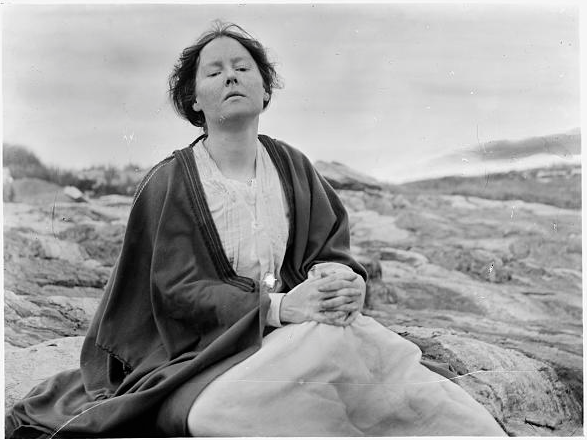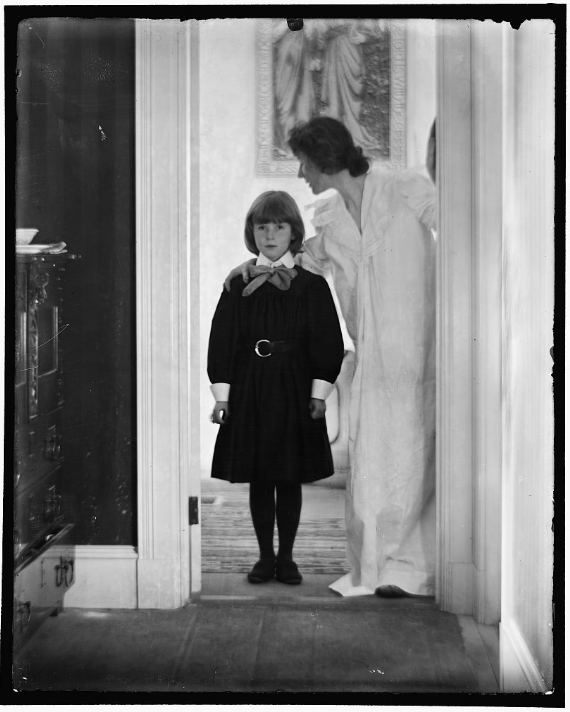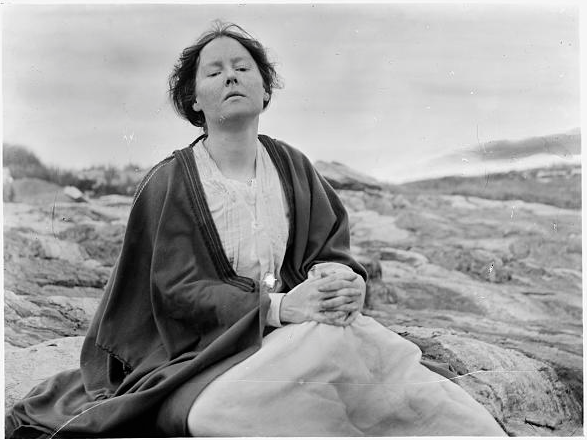This exercise required me to make an in depth study of any historic portrait. The photograph I chose is, The Heritage of Motherhood (1904) by Gertrude Käsebier. While searching the internet, I found that the photograph appears in varying degrees of quality, with a number of different crops and even some mirrored versions.

On my initial viewing of this photograph, I felt as if I was intruding in the subject’s privacy. The woman appears with her hands held together as if at prayer, her eyes are closed and her head has an upward intention. She is placed within a barren and desolate landscape. The loose locks of hair and the shawl upon her shoulders add a coldness and reinforce a sense isolation. The title of the photograph is quite general and only hints at the reason or cause for the woman deep contemplation or prayer. One must speculate that the woman, and mother, is troubled by some worry or concern for a child or children.
Gertrude Käsebier, like Julia Margaret Cameron, came to photography late in life. Käsebier studied art at the Pratt Institute, and turned to portrait photography in order to support her family after her husband became ill. Käsebier belonged to the same Pictorialist school as Alfred Stieglitz which ‘sought to elevate the status of photography to a fine art’ (Bridgers 2014). Käsebier had five of her photographs published in Camera Notes, the official magazine of the Camera Club of New York. Stieglitz (1899) as the magazine’s editor, described her as ‘beyond dispute, the leading portrait photographer in the country’. One of her prints, sold for $100, a new record price of the time. Stieglitz was against commercial photography and while Käsebier had to support her family, a difference of opinion resulted in Käsebier resigning and joining the Professional Photographers of New York (Ang 2014).
The woman in the photograph is Agnes Lee, a friend of Käsebier who sits in the gloomy landscape, grieving the recent death of her daughter. Agnes Less appeared along side her daughter Peggy in an earlier of Käsebier’s photographs entitled, Blessed Art Thou among Women 1899. In that image, Lee is depicted as the mother encouraging her child out to negotiate the world. Religious overtones are again present in this image as a picture of The Annunciation (Angel Gabriel appearing before the Virgin Mary) hangs on the wall (Warner Marien 2010). Peggy died a short time after making the photograph, and so the grieving mother portrayed in the staged photograph, The Heritage of Motherhood 1904, is in fact a fair and true depiction of Agnes Lee’s feelings of loss.

The theme of motherhood is quite strongly represented across much of Käsebier’s work. I find that reading these two images together creates a very powerful and compelling commentary on the trials of parenthood. Together they ‘give us a moment of their truth depicted in an artistic manner, leaving the viewers space to find their own truth, too’ (Perich 2017).
Reference:
Ang, T. (2014) ‘Photography The Definitive Visual History’, London: Dorling Kindersley Limited.
Bridgers, J. (2014) ‘Gertrude Käsebier (1852-1934): An Artistic Success Story’, Picture This Blog Library of Congress Prints and Photos [online], 24 Jul, available: https://blogs.loc.gov/picturethis/2014/07/gertrude-kasebier-1852-1934-an-artistic-success-story/ [accessed 25 Oct 2017].
Halter, P. (2003) ‘Portraits of Women in Early 20th-Century American Photography’, in Maeder, B., eds., Representing Realities Essays on American Literature, Art and Culture, Tübingen: Gunter Narr Verlag Tübingen.
Perich S.T. (2017) ‘Gertrude Käsebier’s photographs about motherhood’, O Say Can You See? Stories from the National Museum of America [online], 12 May, available: http://americanhistory.si.edu/blog/gertrude-kasebiers-photographs-about-motherhood [accessed 25 Oct 2017].
Stieglitz, A. (1899) ‘Our Illustrations’, Camera Notes 3, Jul 1899, p.24.
Warner Marien, M. (2010) Photography: A Cultural History, 3rd ed., London: Laurence King.

